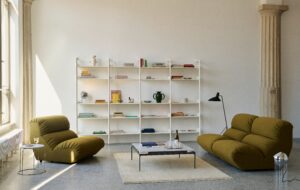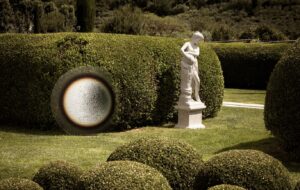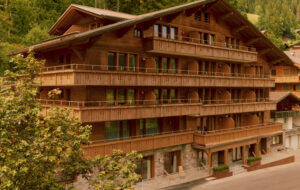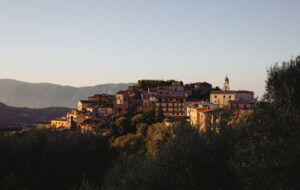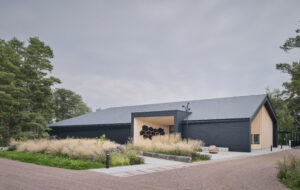The new commission by Carwan Gallery is a reflection on the link between Mahdavi’s work and the erasure of colour from classical art and architecture
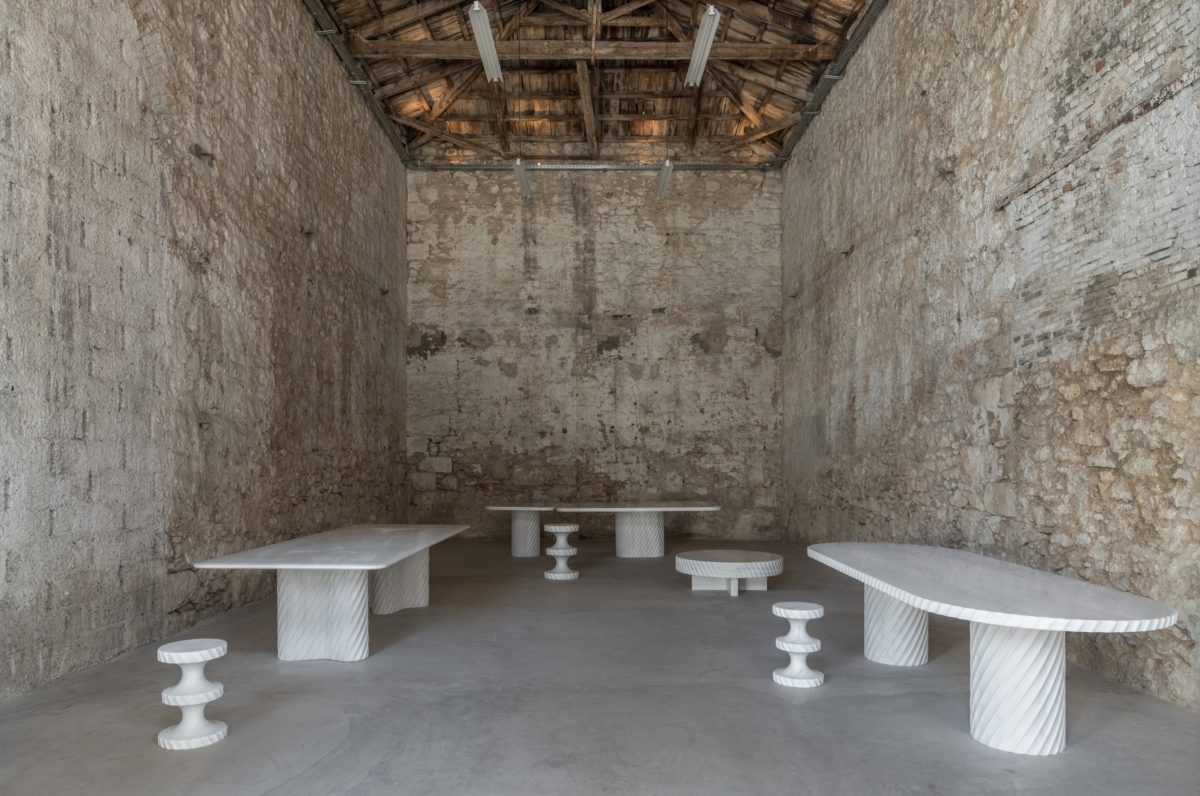 Photography by Giorgos Sfakianakis
Photography by Giorgos Sfakianakis
Words by Alia Akkam
Mesmerising hues are a defining characteristic of India Mahdavi’s vast oeuvre. When hatching Achromia, then, her just-opened exhibition of equally stunning all-white marble objects at the Carwan Gallery in Athens (through August 13), the Paris-based architect and designer was initially stymied by the notion of creating in a manner antithetical to her instincts.
‘It was a huge challenge,’ Mahdavi admits. ‘Not being able to use colour, something that represents joy and optimism to me, felt unnatural, but the process pushed me out of my comfort zone.’ This deprivation of a usually robust palette also never conflicted with the values underpinning Mahdavi’s work. ‘I was glad to have a new perspective, that I was able to find this warmth through another means,’ she adds.
For Achromia, Mahdavi reimagined some of her signature furniture pieces in vibrant Pentelic marble (the same material used to spawn the nearby Parthenon), produced by Delta Marble. Sourced from one block handpicked by Mahdavi that was quarried just north of the city, the marble is imbued with a subtle golden tonality that dovetails with the designer’s love for richness and lustre. Deeply rooted in Greece, it’s a material that ‘truly speaks of the place,’ she adds.
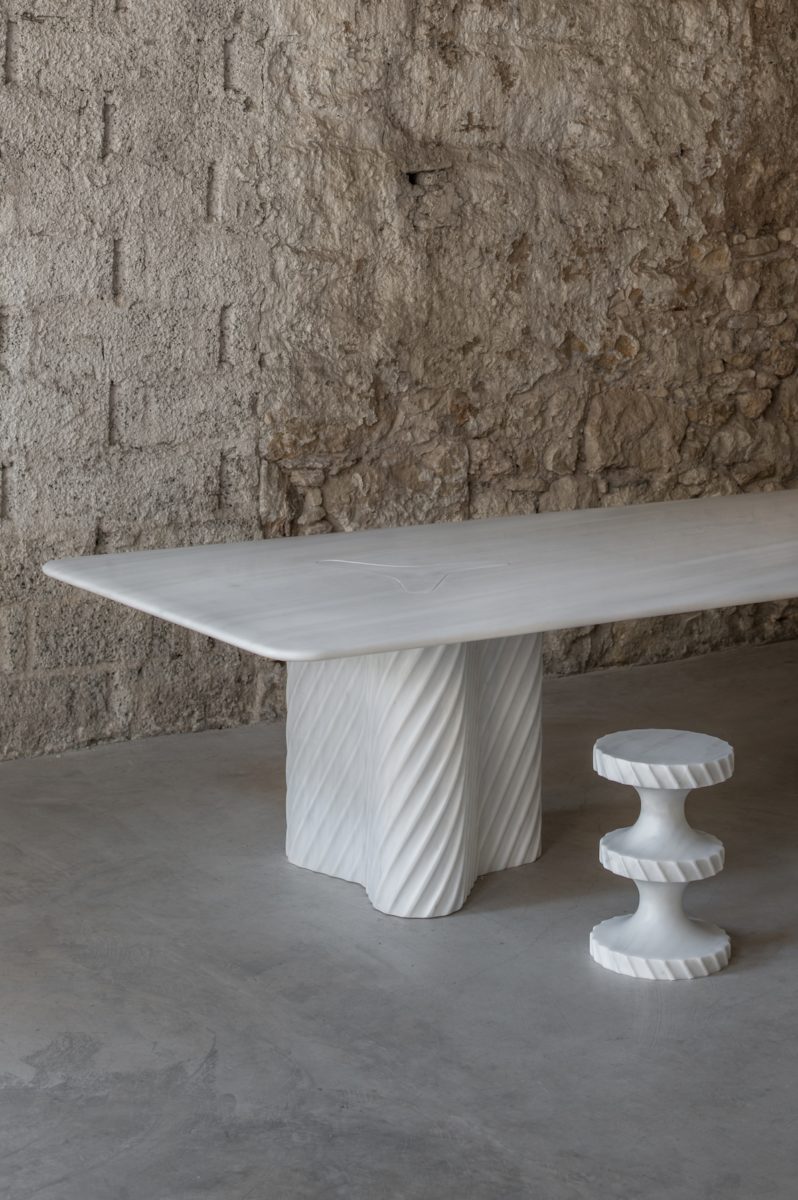 Photography by Giorgos Sfakianakis
Photography by Giorgos Sfakianakis
Although the collection’s forms had long been established prior, transforming them from, say, lacquered wood and brass into marble was no easy feat, as Mahdavi had to thoughtfully reconsider all proportions in relation to the material adjustments. This time around, the furniture, which melds a handmade touch with precise technology (Mahdavi relied on 3D capabilities, for example, to ensure size consistency), have been aptly christened with Greek names.
Take the Bishopos table, a spin on Mahdavi’s three-tiered ceramic Bishop (and its petite sibling, the Babibishopos), originally designed as a bar stool for a New York nightclub that calls to mind hypnotising chess games, or the multifunctional Alberios table that Mahdavi first dreamed up for the late Alber Elbaz’s home as a two-part work and dining station.
The capsule-shaped Elipsi, the low-slung, round Helios and the imposing Diagonos and Double Diagonos are also on display, anchored by hefty, fluid bases that mimic Doric columns, their soft, chiseled grooves capturing light and expressing the texture that Mahdavi always seeks to amplify.
 Photography by Sabine Mirlesse featuring India Mahdavi
Photography by Sabine Mirlesse featuring India Mahdavi
There is indeed an experimental aura to Mahdavi’s undertaking, but her investigation is also a meditation on history, directly linked to an oft-forgotten flamboyant chapter. Snowy marble has always been synonymous with ancient Greek and Roman artifacts, but that unwavering purity is a misconception, for in the past these relics actually embraced geometric patterns and were brightened with unabashedly vivid pigments of crimson and ultramarine, reminiscent of Missoni, as Mahdavi puts it.
Ahcromia, its barrage of white backdropped by Carwan Gallery’s layers of raw brick, invites one to remember that not all things are what they always seemed. After first collaborating with Mahdavi in 2013 at Design Miami/Basel, the gallery’s founder, Nicolas Bellavance-Lecompte, was eager to partner with her again when Carwan relocated from Beirut to Athens in 2020—particularly on a contextually relevant commission befitting of the gallery’s newfound presence in the city’s port neighbourhood of Piraeus.
On a trip to Egypt, ‘I was looking at the temples in Luxor and I saw the bright colours vanishing,’ recalls Bellavance-Lecompte, and that sight reminded him of a 2018 story in The New Yorker magazine about ‘the false idea of colourless classicism and I thought it could be a great concept for India to explore removing the colour from her work, increasing its significance by its absence, exploring the sculptural aspect.’
 Photography by Giorgos Sfakianakis
Photography by Giorgos Sfakianakis
Mahdavi’s arrival in Athens coincides with the capital’s booming art and design scene, what with the unveiling of the National Museum of Contemporary Art Athens (EMST) in an old brewery in 2020, about-to-open shows like Dream On at a former tobacco factory presented by the Hellenic Parliament Foundation and NEON, and last year’s debut of the small, minimalist Hyper Hypo bookstore devoted to visual culture. Even in Piraeus, locals and tourists bolster Carwan pop-ins with wanders through the Objects of Common Interest showroom and the ouzo factory-turned-studio of artist Theodor Psychoyos.
‘It has always been part of the gallery’s mission to bring international actors to our new design destinations,’ points out Bellavance-Lecompte, noting that just as Mahdavi’s Beirut visit elicited a positive response ‘we were all very touched by the warm welcome and feedback of the Greeks. They genuinely enjoyed to talk with her and they were all amazed by the whole project, how it spoke to them culturally as well.’
Get a curated collection of design and architecture news in your inbox by signing up to our ICON Weekly newsletter

